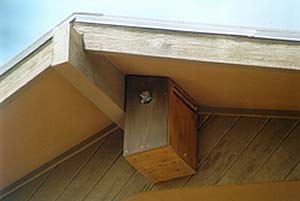Make Them Feel at Home
 Contributed by Bob Powell
Contributed by Bob Powell
I read an article a few years ago on what to do about woodpeckers "drumming" on houses and trying to build nests in the exterior walls. One possible solution to the woodpecker problem was omitted: It can be easier to accommodate these determined birds than to fight them!
Northern flickers were pecking holes below the eaves of my house, just above the deck. Being unsuccessful in chasing them away, I decided to build a home for them based on plans I got from the Colorado Division of Wildlife (see below). I modified the plans a bit and stained the outside of the nest box to blend in with my house.
However, there's a secret to getting them to use it. When first installed the box, they continued to peck on my house—right next to their new home! Frustrated, I got the idea to cover the entrance with a relatively thin piece of wood with a small, ragged hole in the center. They found it irresistible . . . they wanted to finish it themselves! After expanding the hole I started to a size of their liking, they lived there for the entire season.
Northern flickers are beautiful birds and a pleasure to have around. They have been living at "my" house, raising a family, every year since I put up the nest box. The young ones really 'talk it up' when they get hungry.
Each year I cover the hole with another thin piece of wood with a small hole in the center so they could, once again, enlarge it and make it their own. Also, the nest box must be cleaned out and refilled with cedar shavings every year (late in the fall or winter).
Every 4 or 5 years they nearly peck through the 2-inch thick by 12-inch wide boards used to build it. They're pecking away at the box all the time, working to enlarge their nest. "We're woodpeckers and that's what we do," they would probably say! So the house must be rebuilt occasionally, which I did in September, 2006, when they returned looking for a place to stay for the winter.
Build It
Use 1 1/2-inch thick material; pine is okay, but cedar is more weather-resistant.
The entrance hole is cut to 2 1/2 inches in diameter, 16 to 20 inches above the floor.
Inside dimensions should be about 4 1/2 x 4 1/2 to 6 x 6, and the total height about 22 to 26 inches. (Mr. Powell's nest box has a floor dimension of 11 x 8; you may need to experiment with the depth and width dimensions to find out what works best in your location and nest box placement.)
Pack the box with sawdust or wood shavings. (Supposedly, by removing the sawdust, the bird is fooled into thinking it is constructing its own nest!)
A front-sloping, hinged roof will shed rain and provide easy access for re-filling with sawdust or wood shavings next year.
See a plan and cutting diagram for a similar flicker nest box. (This one, however, does not employ a slopped roof.)

